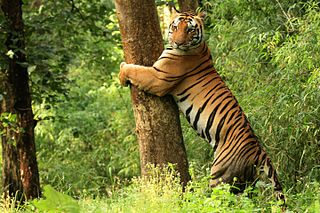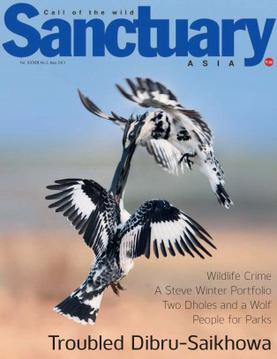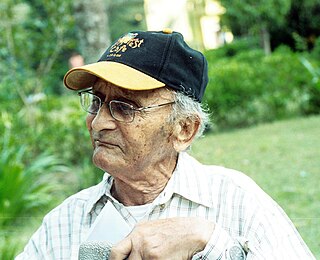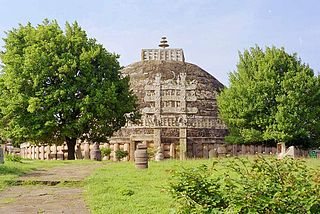Hemendra Singh Panwar | |
|---|---|
| Born | 22 March 1937 Balaghat, Madhya Pradesh |
| Awards | Padma Bhushan |
Hemendra Singh Panwar is an Indian conservationist and civil servant, known for his efforts in the fields of wildlife and conservation. He was the first director of the Wildlife Institute of India and was the director of Project Tiger . [1] The Government of India honoured him, in 2013, with Padma Bhushan, the third-highest civilian award, for his services to the environment and conservation. [2] [3]
Hemendra Singh Panwar was born on 22 March 1937 in Balaghat district of Madhya Pradesh. [4] He started his career in Indian Forest Service, which took off with his posting at Mandla. In 1969, he was transferred to South Mandla which covered the forest areas of Kanha which had a sparse head count of 30 tigers and Barasinghas (swamp deer) numbering 66. [4] Panwar's efforts on deer conservation was given a boost when he was put in charge of barasingha conservation as an independent unit.
During his stint at Kanha, Panwar is reported to be successful in converting the park into an efficiently managed unit, and the park won the award for the best managed park in India in 1976. The headcount of tigers grew to 150 and the deer to over 400 and the park management was able to relocate 22 interior villages. [4]
In 1981, Panwar was transferred to Delhi, as the head of Project Tiger, a project conceptualised in 1973, for the protection of tiger population in India. He worked for 4 years on the project, till 1985, during which time, the project brought seven additional reserves under its umbrella. The population of tigers in India rose from 1900 to 3000. [4] He was also invited to present a paper on the subject by the Smithsonian Institution. [1]
At this time, the idea of setting up an institute focusing wildlife conservation was being mooted by V. B. Saharia, and as a result of his efforts, the Wildlife Institute of India was established in 1985 with Hemendra Singh Panwar as its first director. Panwar established the institute into a full-fledged learning centre with specialised focus on wildlife biology, management, and extension. Research facilities were also set up in the topics of focus. The Wildlife Institute of India is rated as one of the six best conservation research institutions by the World Conservation Union and has won Rajiv Gandhi Conservation Award. Panwar retired as its director in 1994. [1]
Hemendra Singh Panwar has won several awards and honours for his services.
Project Tiger is a tiger conservation programme launched on April 1,1973 by the Government of India during Prime Minister Indira Gandhi's tenure. The project aims at ensuring a viable population of the Bengal tiger in its natural habitats, protecting it from extinction, and preserving areas of biological importance as a natural heritage that represent the diversity of ecosystems across the tiger's range in the country. The project's task force visualised these tiger reserves as breeding nuclei, from which surplus animals would migrate to adjacent forests. Funds and commitment were mustered to support the intensive program of habitat protection and rehabilitation under the project.

The Bengal tiger is a population of the Panthera tigris tigris subspecies and the nominate tiger subspecies. It ranks among the biggest wild cats alive today. It is considered to belong to the world's charismatic megafauna.

The Satpura Range is a range of hills in central India. The range rises in eastern Gujarat running east through the border of Maharashtra and Madhya Pradesh and ends in Chhattisgarh. The range parallels the Vindhya Range to the north, and these two east–west ranges divide Indian Subcontinent into the Indo-Gangetic plain of northern India and the Deccan Plateau of the south. The Narmada River originates from north-eastern end of Satpura in Amarkantak, and runs in the depression between the Satpura and Vindhya ranges, draining the northern slope of the Satpura range, running west towards the Arabian Sea. The Tapti River originates in the eastern-central part of Satpura, crossing the range in the center and running west at the range's southern slopes before meeting the Arabian Sea at Surat, draining the central and southern slopes of the range. Multai, the place of Tapi river origin is located about 465 kilometer far, south-westerly to Amarkantak, separated across by the hill range. The Godavari River and its tributaries drain the Deccan plateau, which lies south of the range, and the Mahanadi River drains the easternmost portion of the range. The Godavari and Mahanadi rivers flow into the Bay of Bengal. At its eastern end, the Satpura range meets the hills of the Chotanagpur Plateau. The Satpura Range is a horst mountain and is flanked by Narmada Graben in the north and much smaller but parallel Tapi Graben in the south.

Bandhavgarh National Park is a national park of India, located in the Umaria district of Madhya Pradesh. Bandhavgarh, with an area of 105 square kilometres (41 sq mi), was declared a national park in 1968 and then became Tiger Reserve in 1993. The current core area is spread over 716 square kilometres (276 sq mi).

Kanha Tiger Reserve, also known as Kanha–Kisli National Park, is one of the tiger reserves of India and the largest national park of the state of Madhya Pradesh. The present-day Kanha area is divided into two protected areas, Hallon and Banjar, of 250 and 300 km2, respectively. Kanha National Park was created on 1 June 1955 and was designated a tiger reserve in 1973. Today, it encompasses an area of 940 km2 (360 sq mi) in the two districts Mandla and Balaghat.
Ranthambore National Park is a national park in Rajasthan, India, with an area of 1,334 km2 (515 sq mi). It is bounded to the north by the Banas River and to the south by the Chambal River. It is named after the historic Ranthambore Fort, which lies within the park.

Mandla District is a district of Madhya Pradesh in central India. The town of Mandla is the administrative headquarters of the district. It is part of Jabalpur Division.

The Dudhwa National Park is a national park in the Terai belt of marshy grasslands in northern Uttar Pradesh, India. It stretches over an area of 490.3 km2 (189.3 sq mi), with a buffer zone of 190 km2 (73 sq mi). It is part of the Dudhwa Tiger Reserve in the Kheri and Lakhimpur districts. The park is located on the Indo-Nepali border in the Lakhimpur Kheri District, and has buffers of reserved forest areas on the northern and southern sides. It represents one of the few remaining protected areas of the diverse and productive Terai ecosystem, supporting many endangered species, obligate species of tall wet grasslands and species of restricted distribution.

Panna National Park is a national park located in Panna and Chhatarpur districts of Madhya Pradesh in India. It has an area of 542.67 km2 (209.53 sq mi). It was declared in 1994 as the twenty second Tiger reserve of India and the fifth in Madhya Pradesh, Panna was given the Award of Excellence in 2007 as the best maintained national park of India by the Ministry of Tourism of India. It is notable that by 2009, the entire tiger population had been eliminated by poaching with the collusion of forest department officials.

The barasingha, also known as the swamp deer, is a deer species distributed in the Indian subcontinent. Populations in northern and central India are fragmented, and two isolated populations occur in southwestern Nepal. It has been extirpated in Pakistan and Bangladesh, and its presence is uncertain in Bhutan.

Kailash Sankhala was an Indian biologist and conservationist. He was the Director of Delhi Zoological Park and Chief Wildlife Warden of Rajasthan. He is best known for his work in preserving tigers. Sankhala was the first Director of Project Tiger, a conservation programme set up in India in 1973. He was well known as "The Tiger Man of India". He was awarded the Padma Shri in 1992 and Rajasthan Ratan in 2013.

The Wildlife Institute of India (WII) is an autonomous natural resource service institution established in 1982 under the Ministry of Environment Forest and Climate change, Government of India. WII carries out wildlife research in areas of study like Biodiversity, Endangered Species, Wildlife Policy, Wildlife Management, Wildlife Forensics, Spatial Modeling, Ecodevelopment, Ecotoxicology, Habitat Ecology and Climate Change. WII has a research facility which includes Forensics, Remote Sensing and GIS, Laboratory, Herbarium, and an Electronic Library. The founder director was V. B. Saharia while the first Director was Hemendra Singh Panwar who remained the director from 1985 to 1994. Trained personnel from WII have contributed in studying and protecting wildlife in India. The national tiger census or the All India Tiger Estimation, is done by WII along with NTCA and state forest departments.

Sanctuary Asia is an Indian nature and wildlife conservation magazine founded in 1981 by Bittu Sahgal, its current editor. The magazine expanded in 2015 to become established as a non-profit foundation.

Kunwar "Billy" Arjan Singh was an Indian hunter turned conservationist and author. He was the first who tried to reintroduce tigers and leopards from captivity into the wild.

Tourism in Madhya Pradesh has been an attraction of India because of its location in the centre of the country. Madhya Pradesh has won Best Tourism State National award for 3 consecutive years i.e. 2017, 2016 and 2015.

Madhya Pradesh, often called the Heart of India, is a state in central India. Its capital is Bhopal. Madhya Pradesh was originally the largest state in India until November 1, 2000 when the state of Chhattisgarh was carved out. It borders the states Uttar Pradesh, Chhattisgarh, Maharashtra, Gujarat and Rajasthan.

The Dudhwa Tiger Reserve is a protected area in Uttar Pradesh that stretches mainly across the Lakhimpur Kheri and Bahraich districts and comprises the Dudhwa National Park, Kishanpur Wildlife Sanctuary and Katarniaghat Wildlife Sanctuary. It covers an area of 1,284.3 km2 (495.9 sq mi) and includes three large forest fragments amidst the matrix dominated by agriculture. It shares the north-eastern boundary with Nepal, which is defined to a large extent by the Mohana River. The area is a vast alluvial floodplain traversed by numerous rivers and streams flowing in south-easterly direction. It ranges in altitude from 110 to 185 m.

The Maikal Hills are range of hills in the state of eastern Madhya Pradesh and Chhattisgarh India. The Maikal Hills are an eastern part of the Satpuras in Kawardha District of Chhattisgarh and Anuppur district of Madhya Pradesh, overlooking the scenic town of Kawardha. Their altitudes range from 340 m to 942 m above sea level. This densely forested and thinly populated range gives rise to several streams and rivers including the tributaries of Narmada and Wainganga rivers. The hills are inhabited by two tribal peoples, the Baigas and the Gonds. The hill range is rich in flora and fauna wealth.

Satkosia Tiger Reserve is a tiger reserve located in the border of Angul and Nayagarh district of Odisha, India covering an area of 988.30 km².
Martand Singh was an Indian wildlife conservationist, parliamentarian and the last ruling Maharaja of the princely state of Rewa. Born in 1923 to Gulab Singh at Fort of Govindgarh, then the Maharajah of Rewa, he did his college studies at Daly College, Indore and continued at Mayo College, Ajmer from where he graduated in 1941. After the death of his father in 1946, he became the Maharajah of Rewa and retained the title, but not the power, until the government abolished royalty in 1970.